lessonplan详细版
Lesson plan

Lesson plan——Life in the futureStudents: 40 Junior high students, Grade 2Lesson duration: 40 minutesTeaching aims: (3mins)1.Predicting the good and bad changes in the future.2.Imagine the alien creatures.3.To arouse students’ interest in learning about the future life.Functions: (5mins)做出预测(Making predictions)Do you suppose that…? Suppose that…I wonder if…Do you imagine that…? I imagine that…猜测未来(Making conjectures about future)Is it likely/unlikely that…Possibly…It is possible that…Most likely…I’m sure…Probably…Suppose that…Perhaps…Maybe…Teaching Methods: 1. First and careful reading.2. Asking and answering question activity.Teaching procedures (30mins)Step1. Reading and learning new words. Fast reading and careful reading.Step2. Warming up.Talk about how many changes there have been in the last one thousand years. And what changes we might expect to find in the next one thousand years. (Direct the students to have a discussion in groups of 4-6, ask the leader of each group to make aAnswer the following questions1.How did people travel 1000 years ago?2.How do you usually go to school?3.How would you like to go to school in the future?4.Where would you like to live in the future? Would you like to live on the moon?5.Can you imagine what life will be like in the future?Step3. Learning the passage——First ImpressionsGrammar of this passage: (This is also the difficult point in this lesson.)1.过去分词作定语(The past participle as the attribute)I followed him to collect a hovering carriage driven by computer.Tomorrow you will be ready for some visits organized by computer.2.过去分词作状语(The past participle as the adverbial)Worried about the journey, I was unsettled for the first few days.Confused by the new surroundings, I was hit by the lack of fresh air. Difficult sentences1.Worried about the journey, Iwas unsettled for the first few days.2.Well known for their expertise, his parents’ company named ”future tours”.3.Transported me safely into the future in a time capsule.4.Cofused by the new surroundings, I was hit by the lack of fresh air.5.Arriving home, he showed me into a large bright, clean room.6.Exhausted, I slid into bed and fell fast asleep.Homework (2mins)Doing exercise1 in page 19 in the book. Doing exercise2 in your exercise book. Review the new words and difficult sentences.。
Unit 4 Lesson Plan
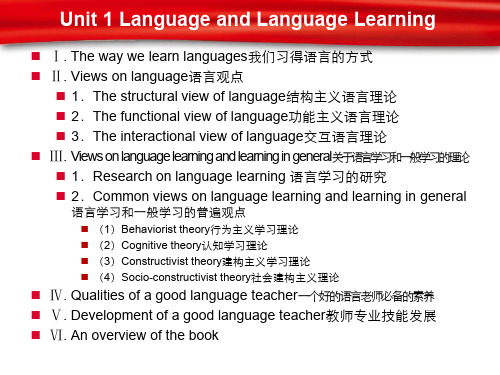
Warm-up/a starter/revision
Presentation
Drilling
Consolidation
Ⅱ.Principles for good lesson planning Ⅲ. Macro planning vs. micro planning Ⅳ.Components of a lesson plan
1.Background information 2.Teaching aims 3.Language contents and skills 4.Stages and procedures 5.Teaching aids 6.End of lesson summary 7.Optional activities and assignments 8.After lesson reflection Ⅴ. Lesson planning Ⅵ.Conclusion
To know what his/her students are able to achieve To focus on the learners’ performance
IV. Components of a lesson plan
Language Contents and Skills
Language Skills
语言学习和一般学习的普遍观点
(1)Behaviorist theory行为主义学习理论 (2)Cognitive theory认知学习理论 (3)Constructivist theory建构主义学习理论 (4)Socio-constructivist theory社会建构主义理论
Ⅳ. Qualities of a good language teacher一个好的语言老师必备的素养 Ⅴ. Development of a good language teacher教师专业技能发展 Ⅵ. An overview of the book
Lessonplan

Lesson planPEP3B Unit4Teacher:Luoxiao qinPeriod:PartA Lesso n2Type:New classDurati on :40mi ns学习目标知识目标:1、我能够听说认读两个名词chair、desk、三个介词on、in、under 并能在实际生活中恰当使用。
2、我能听懂、会说句型“Where is…?It ' s in/on/und并能够在真实的情景中运用。
能力目标:我能够运用句型在生活中询问物体的方位并作出正确的回答。
情感态度:我能养成良好的生活习惯,摆放好自己的物品,不要乱扔乱放。
学习过程(一) 热身/复习(Warm-up/Revision )课前(1)classroom rules.(1.clap hands XX_ XXX 2.Say ab&cd)(2)Grouping(count froml to 6))(3) 1 wanna find which group is the champion.Ok, let ' s go. Fighting! Go go go !(二) 呈现新课(Presentation)15 '1) Greeting.Hi,Hello,Nice to meet you.2) Lind in: Today I ' m very glad to be your new English teacher. Do you want to know me? I ' m ofte n con fused. Because I am so busy. Look, this is my room. 展示PPT : Wow, That' s terrible.So,kids please help me to tidy my room. Will you? Ok ,let ' s go! 3) Study the new words desk and chair use phonics acti ons.T: What can you see in my room? What is it? It ' asdesk .教师用TPR和phonics教学生认读单词desk and chair.(操练这两个新单词。
Lesson plan 详细版.pptx

英语教案-lessonplan
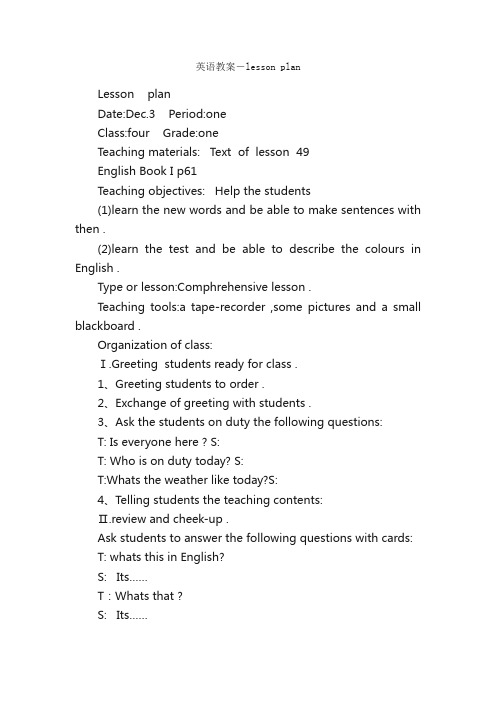
英语教案-lesson planLesson planDate:Dec.3 Period:oneClass:four Grade:oneTeaching materials: Text of lesson 49English Book I p61Teaching objectives: Help the students(1)learn the new words and be able to make sentences with then .(2)learn the test and be able to describe the colours in English .Type or lesson:Comphrehensive lesson .Teaching tools:a tape-recorder ,some pictures and a small blackboard .Organization of class:Ⅰ.Greeting students ready for class .1、Greeting students to order .2、Exchange of greeting with students .3、Ask the students on duty the following questions:T: Is everyone here ? S:T: Who is on duty today? S:T:Whats the weather like today?S:4、Telling students the teaching contents:Ⅱ.review and cheek-up .Ask students to answer the following questions with cards: T: whats this in English?S: Its……T:Whats that ?S: Its……T:Is this(that) a(an)……?S:Yes , it is ./No, it isn t .Ⅲ. Presentation of the new materials:1、Teching the following new words with a small blackboard .1)What colour is it ?(Teacher point to the pictures on the small blackboard)Itsblack/red/white/green/yellow/blue/purple/brown/orange/grey.( students read out aloud)2)Whats colour is it ? (Teacher point to the classroom in the picture)Its…(red) . (students read aloud)2、Teach the text:1)Put up some pictures and ask students to listen to the recording of the text while looking at the picture.(again and again)2)Ask the students some questions to cheek them .①Whats this (that) ?②Is this (that) a car ?③What colour is it ?④Its…(black) .Its a …(black) car .3)Explain some language points:①There is a car on the hill in the picture . (Explain why use "on" instead of "in")②A:what colour is it? B:Its black. Its a black car. (Extlain "black" and " a black car "the use of sentences) .Ⅳ. Reinforcement :1、Reading the text after the recording and the teacher gives some guideline to the pronuncition and intonation of reading the text .2、Ask students to read the text .3、Ask students to give some questions on the pictures and give answer.4、Play a game use pictures ( T : Act it.Ask students do it like this )Ⅴ. Summary:Today were learned some new words and the text please pay attention to those words in the text. (pointing to some important points)Ⅵ. Design for exercises:1、Homework:1)Revise the dialogues in lesson 49 .2)Write the new words .3)Finish the workbook esercises. Do Ex 2,3 in the exercise book .2、Additional exercises :A)词组互译:1、一只红色的风筝2、一朵黄色的花3、一辆蓝色的小汽车4、一只黑色的猫5、一只白色的鸟6、一个绿色的苹果B)Fill in the blank:A:Whats over there?B: ?A:Over there, the hill.B: a car.A: is it ?B:Its red. Its a red .A:Is a car , too ?B: , it is .A:What colour is it ?B:Its . Its a black car.。
少儿英语启蒙 英语游戏 lesson plan01-introduction 超详细教学步骤内容
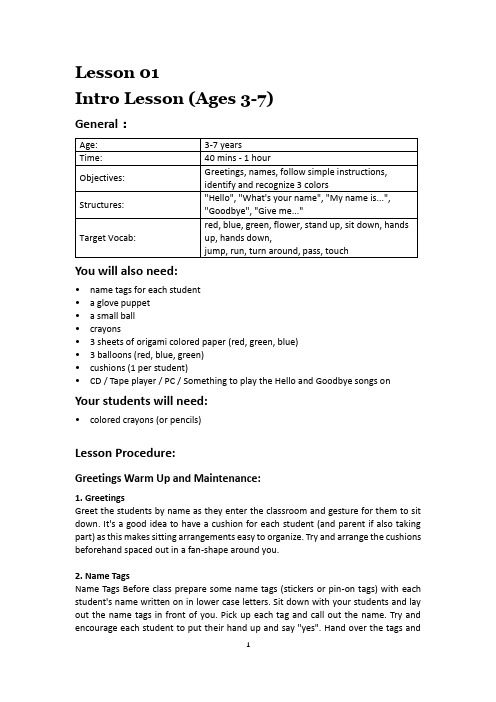
Lesson 01Intro Lesson (Ages 3-7) General:Age: 3-7 years Time: 40 mins - 1 hourObjectives: Greetings, names, follow simple instructions, identify and recognize 3 colorsStructures: "Hello", "What's your name", "My name is...", "Goodbye", "Give me..."Target Vocab: red, blue, green, flower, stand up, sit down, hands up, hands down,jump, run, turn around, pass, touchYou will also need:•name tags for each student• a glove puppet• a small ball•crayons• 3 sheets of origami colored paper (red, green, blue)• 3 balloons (red, blue, green)•cushions (1 per student)•CD / Tape player / PC / Something to play the Hello and Goodbye songs on Your students will need:•colored crayons (or pencils)Lesson Procedure:Greetings Warm Up and Maintenance:1. GreetingsGreet the students by name as they enter the classroom and gesture for them to sit down. It's a good idea to have a cushion for each student (and parent if also taking part) as this makes sitting arrangements easy to organize. Try and arrange the cushions beforehand spaced out in a fan-shape around you.2. Name TagsName Tags Before class prepare some name tags (stickers or pin-on tags) with each student's name written on in lower case letters. Sit down with your students and lay out the name tags in front of you. Pick up each tag and call out the name. Try and encourage each student to put their hand up and say "yes". Hand over the tags andhelp to pin / stick on.In later lessons, once your students can recognize their written name, you can have them pick out their own name tags.New Learning and Practice:1.Play "Ball Pass" and say namesTake a soft ball and pass it to your nearest student, saying "Pass". Have each student pass the ball around the circle. Next, hold the ball and say your name. Have each student say their name as they pass the ball to each other. Make sure they pass, not throw, roll, etc. If a student doesn't pass make sure s/he does it again until done properly.2.Introduce glove puppet - greetings and introductions activityYour students will love this. Get hold of a glove puppet (I use Cookie Monster bought from Toys 'R' Us) and put it in a bag before class. Bring out the bag, open it enough to see in and shout into the bag "Hello!". Then move your ear to the opening to listen - nothing. Go to each student and encourage them to shout "Hello" into the bag - each time nothing happens. Finally, get all the students together to shout "Hello!" at the same time. This time the puppet wakes up and jumps out of the bag! Then model the role play with the puppet:Introduce glove puppet - greetings and introductions activity Teacher:"Hello", What's your name?"Puppet:"My name is...".Then move onto the first student and say "Hello". Encourage him/her to say hello back. Let the students touch, cuddle and stroke the puppet. My puppet also likes to nibble their feet and arms. Next, the puppet asks each student: "What's your name?". If they are old enough try and encourage "My name is..." but for the really little ones (3 and under) just saying their name is fine. Finally, go around saying "Goodbye" and "See you" before going back into the bag and back to sleep.3.Sing the "Hello Song"Sing the "Hello Song" Sit in a circle and listen to the song (clap along or pat knees). Play it once more emphasizing "Hello". Your students will pick up the words surprisingly quickly.Alternatively, you can sing the "Hello, Hello" song following the tune of Frere Jacques: Hello, hello, Hello, hello,How are you? How are you?I'm fine, thank you, I'm fine, thank you,We're ok, We're ok.Lyrics for "The Hello Song"Hello, hello,How are you today?Hello, hello,How are you today?I’m fine, thank you,I’m fine, thank you,I’m fine, thank you,And how about you?Hello, hello,How are you today?I’m fine, thank you,And how about you?Gestures for "The Hello Song"These are quite straight forward. First time you play the song do the gestures and encourage everyone to do them with you.Wave as you sing the "Hello, hello" parts.Gesture to others as you sing "How are you today?"Point to yourself as you sing "I’m fine, thank you"Hand gesture towards another student as you sing "And how about you?".4. Do "Exercise Routine" activityTime for some action. Say the following and have the students follow your lead:Do "Exercise Routine" activity" Stand up (T stands and so does everyone else) "Hands up / hands down" (do 4 or 5 times)"Jump" (4 or 5 times)"Run! / Stop!" (4 or 5 times)"Turn around! / Stop!" (4 or 5 times)finally "Sit down".5. Name writing practiceIn this lesson your students are going to practice writing their names. For really young ones, this may be their first time to do so - don't worry if their first effort is a scrawly mess - always encourage and praise.You will need to prepare a writing sheet for each student before class with their name written in dots for them to practice tracing their names .Prepare the sheets something like this:6. Do the Name Flower Craft activityDo the Name Flower Craft activityNow that everyone has had a chance to practice writing their name you can do the name craft activity.Before class print out the "Name Flower Craft" sheet and copy / cut out the flower shapes so that there are enough to give one to each student (do a few extra in case of emergencies!).Get each student to write their name on the line and then color in their flower. Students can now decorate the classroom by sticking their name flowers on the walls. Alternatively, have students make a name poster by sticking all of the name flowers onto one large piece of construction paper (I like to make a tree shape out of brown card for students to stick their flowers on).7.Teach Colors: red, blue, greenTeach Colors: red, blue, greenA great lesson to follow this one is the "Colors Lesson" (you can download it for free at our website). In this lesson you can start by teaching the first 3 colors (red, blue and green) and then in the next class you can continue with the other colors (yellow, pink, purple, orange).Origami paper is great for this, or just some colored paper/card cut into squares. Sit everyone in a circle and hold up the first colored paper and elicit the color (e.g. red). Chorus and practice saying the color. Do this for the rest of the colors.8.Play "Color Pass", "Color Touch" and "Color Hold Up"Play "Color Pass", "Color Touch" and "Color Hold Up"Now take each color and pass it to your nearest student. Say "red" as you pass red, etc. The students pass the colors round the circle. Next, lay the 3 colors in the middle of the circle. Say "Hands up". Students raise their hands. Then say "Touch.....red!" and the students should all try and touch the red colored paper. Do for all of the colors. Finally, give each student one of the colored papers. Say "Hold up....blue!" - the students holding the blue papers raise them into the air.NOTE: for these games you'll probably have to give lots of help and encouragement. For example, if one of your students doesn't hold up the colored paper when asked look at him/her and gesture what to do. If their mothers are with them have them help.9.Play "Find the Color"Now get each student to give you back their colored paper by saying "Give me (blue)". Collect all the colors. Then place the colored papers on the floor around the room. First model by saying "Touch blue". Then stand up, go to a blue paper, touch it and say "blue" and go back to your place. Now say to one student "(Miki), touch green" and that student should stand up, find the correct color and touch it. Get everyone to have at least one go. Finally, get students to stand up and give you back the colors as you say them (e.g. Paulo, give me red").10.Play "Balloon Kick"You need three balloons - a red, a blue and a green one. Take one balloon and elicit the color. Then chorus "(blue) balloon" x3. Now blow up the balloon (little kids love watching this) and tie the end. Pat the balloon to one student and encourage him/her to say its color as they catch it. Let the student pat it back to you and repeat the color with all students. Then do the same for the other 2 balloons. Finally, line the balloons up, have the students stand up and model the activity: "Ok, (your name) kick the (blue) balloon!", then run up to the (blue) balloon and kick it. Now instruct one student to kick a balloon, give loads of help and encouragement and then do with all the other students.Wrap Up:1.Assign Homework: "Color the Balloons"Hold up the homework worksheet and model coloring in the 3 balloon pictures (in red, blue and green). Elicit each color as you go. Give out the worksheets and say "Put your homework in your bags" and help them to do so - this is important as they will probablywant to start coloring them right away.2. Say Goodbye to glove puppetSay Goodbye to glove puppetTake out the bag again and get everyone to wake up the glove puppet by shouting its name into the bag (e.g. "Cookie Monster!"). Bring out the puppet and go through the same routine - go to each student and say hello, ask their name and the say goodbye / see you. Then put the puppet back in the bag (back to sleep).3.Sing "Goodbye Song"The "Goodbye Song" is a great way to sign off the class. Sit together in a circle and sing and clap along.。
LessonPlan英语课程计划.
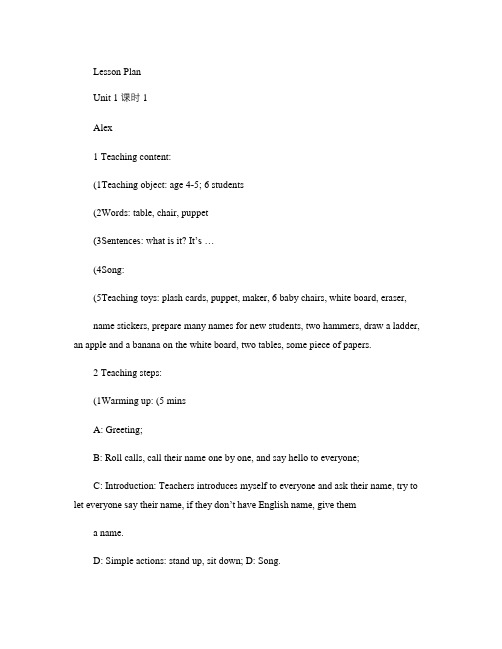
Lesson PlanUnit 1 课时1Alex1 Teaching content:(1Teaching object: age 4-5; 6 students(2Words: table, chair, puppet(3Sentences: what is it? It’s …(4Song:(5Teaching toys: plash cards, puppet, maker, 6 baby chairs, white board, eraser,name stickers, prepare many names for new students, two hammers, draw a ladder, an apple and a banana on the white board, two tables, some piece of papers.2 Teaching steps:(1Warming up: (5 minsA: Greeting;B: Roll calls, call their name one by one, and say hello to everyone;C: Introduction: Teachers introduces myself to everyone and ask their name, try to let everyone say their name, if they don’t have English name, give thema name.D: Simple actions: stand up, sit down; D: Song.(2Words presentation: (20 minsA: Words: chair, puppet, and table. Real object; flash cards; CDB: Practice for words: Together, show the flash cards one by one, loud and small sound and tone to say every word.Individual: by kissing, touching and kicking to say the word. Hammer gameGroup work: two groups, each team s students.Start single – Name – Rules – Game – The end singleSpread the flash cards on the floor, when the teacher says aword and they need to hit the word and say it. The winnercan be the teacher one time and say a word let the otherstudent hit it, besides; the winner group can have one stepup the ladder. The winner group can have two stars for eachone. Collect the flash cards and do the ends single.(10 minsC: Production: Check. Racing game; two groups. (10 minsStart single -- Name the gameRules: let a student do an example with the teacher; make two lines –the top two students hold the hammer before the teacher givethe single;When the teacher says a word the student goes and find it, andsay the word.The winner group can have two starts.Start – the end single(3Sentences presentation: (15 minsA: answer: listen to the CDB: practice: It’s …Individually: craw craw craw (game.Rules: place two tables end to end, make a line and they craw under the table from the top to the end, the teacher will waiting for them at the endof the table. The teacher says: “what is it?”T hen each kid can get a chanceto practice: It’s …Together: what is it? It’s …Group work: two groups. Keep going the ladder game.Now the students ask the teacher question. The group that louder than another one can have one step up,C: production: checkTwo teams: racing gameSingle – name – rulesRules: the teacher opposite to the students, when the teacher says goes, theyjump/craw/ hop/run to the teach er; the teacher says: “what is it?” the first one who can answer the question and jump/craw/… back to the line, they will win.Start – the end actionCommunication: five stepsRules: each student draw a picture (chair, table and puppet; the teacher ask a student do an example, the teacher says: “what is it?” the student look at the teacher’s picture and say the answer, then the student ask the teacher the question,, after that they change their picture and go to find others do the same thing; when they change one time they can get a poker. The winner could be the one have the most pokers.Start – endThe minutes breakThe second class (40 minsTeaching steps:(1Review “what is it, It’s …” (5 mins(2Letter A a B b (10 mins flash cards A a B b same hammer game.(3Hand out some pictures to the students: chair table puppet; trace A aB b. (when the students do the drawing things the teacher canreview again by individually (15 mins(4Wrap up (10mins: review all the stuff (5 mins;Line up, train game;Homework: tell their parentsGoodbye :( If some parents want to know their kids’ behavior you can let them wait after the class.。
Lesson Plan
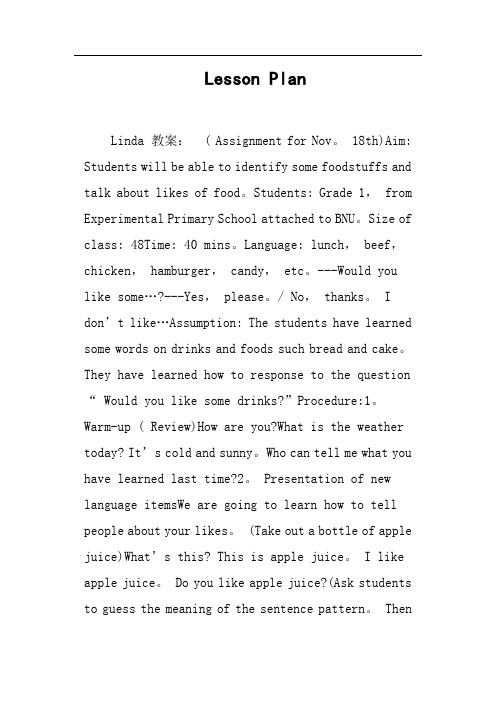
Lesson PlanLinda 教案: ( Assignment for Nov。
18th)Aim: Students will be able to identify some foodstuffs and talk about likes of food。
Students: Grade 1, from Experimental Primary School attached to BNU。
Size of class: 48Time: 40 mins。
Language: lunch, beef,chicken, hamburger, candy, etc。
---Would you like some…?---Yes, please。
/ No, thanks。
I don’t like…Assumption: The students have learned some words on drinks and foods such bread and cake。
They have learned how to response to the question “ Would you like some drinks?”Procedure:1。
Warm-up ( Review)How are you?What is the weather today? It’s cold and sunny。
Who can tell me what you have learned last time?2。
Presentation of new language itemsWe are going to learn how to tell people about your likes。
(Take out a bottle of apple juice)What’s this? This is apple juice。
LessonPlan教案

Lesson Plan 教案
Learning objectives學習目標:
Prior Knowledge & skills已有知識及技能:
教學活動及流程:
# 展示在教學活動中為照顧高能力/資優學生而調適的教學內容和策略。
學習評估:
Lesson Plan 教案
Learning objectives學習目標:
Prior Knowledge & skills已有知識及技能:
教學活動及流程:
#展示在教學活動中為照顧高能力/資優學生而調適的教學內容和策略。
學習評估:
Lesson Plan 教案
Learning objectives學習目標:
Prior Knowledge & skills已有知識及技能:
教學活動及流程:
香港進食失調康復會有限公司派員到校主講《瘦身文化面面觀》講座
全級進行
# 展示在教學活動中為照顧高能力/資優學生而調適的教學內容和策略。
學習評估:
Lesson Plan 教案
Learning objectives學習目標:
Prior Knowledge & skills已有知識及技能:
教學活動及流程:
#展示在教學活動中為照顧高能力/資優學生而調適的教學內容和策略。
學習評估:
Lesson Plan 教案
Learning objectives學習目標:
Prior Knowledge & skills已有知識及技能:
教學活動及流程:
#展示在教學活動中為照顧高能力/資優學生而調適的教學內容和策略。
學習評估:。
英语课例《Lessonplanning》

英语课例《Lessonplanning》Lesson planning教学内容:Unit 5 Look at the monkeys B Let’s learn( Grade 5 下第4课时)教学目标:1.能够听、说、读、写动词和动词短语的ing形式:sleeping 、 climbing 、fighting、 swinging、 drinking water2.能够听懂、认读句子What are the elephants doing ?They’re drinking.教学重难点:1. 重点是五个动词短语的ing形式。
2. 难点是四会掌握五个动词短语的ing形式并能够运用其正确形式描述动物的行为。
课前准备:多媒体平台、录音机、磁带、练习题、单词卡片教学过程:一、Warm-up1、 Greeting2、Have a free talk:What is it doing ?----It’s ... (runnin g、 walking、swimming).二、Presentation1、Tell a story:Jerry comes in Tom’s home. Ha, ha…Xu… Tom is sleeping. Sleeping, sleeping, it’s 4sleeping. Look! The fruit is there. Yeah, yeah, yeah! Swinging, swinging, it’s swinging. Er…I’m thirsty. Drinking water, drinking water, it’s drinking water. Oh…no...Tom wakes up. Fighting, fighting, they are fighting. It’s dangerous. I must go. Climbing, climbing, it’s climbing.2、Answer the questions and teach the words:①Picture 1, what is Tom doing?(Team 1) 【sleeping】②Picture 2, what is Jerry doing? (Team 2)【 swinging】③Picture 3, what is the Jerry doing? (Team 3)【drinking water】④Picture 4, what are Tom and Jerry doing? (Team 4)【fighting】⑤Picture 5, what is Jerry doing? (抢答) 【climbing】3、Teaching grammar: 现在进行时【be动词 + 动词ing形式】三、Practice1、Read after the tape2、Read after the teacher3、Read in the whole class4、Read in the group of 45、Check reading四、Production1、Play a game—You are mine请两名同学上来猜拳赢单词,赢得改单词的同学要带领全班读吹该单词,最后看哪个同学赢得最多的单词。
Unit-4-Lesson-Planning教学内容
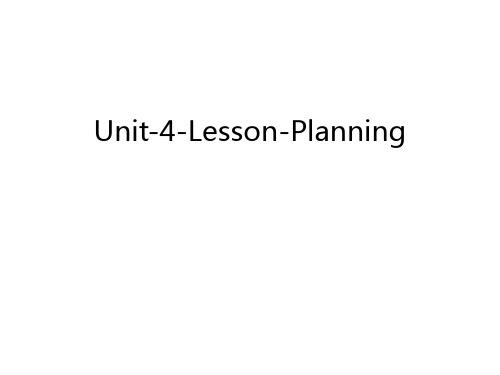
problems
What to write in after school reflection
what happened, students’ performances, unexpected incidents, surprises, things went well, things went wrong, things to be improved things to be given more attention
5. Linkage: the stages and the steps within each stage are linked with one another.
A plan is just a plan.
Things often do not happen according to our plan no matter how experienced we are.
Before the lesson ????
After the lesson ????
Before the leids activities techniques time potential problems
After the lesson
3. Knowing about the learners
Age range, sex proportion, social background, motivation, attitudes, interests, learning needs, etc.
4. Knowing about the curriculum/syllabus
英语教案Lesson plan

Lesson planBackground information:Students: 60 Junior high school students, Grade1Lesson duration: 45 minsTeaching objectives:By the end of the lesson, students should be able to:1.Say in English the plurals of Nouns.2.Ask and answer questions about the Nouns.e the interview Strategies to ask information and take notes.4. learn to be a good listener and brave to ask questions in English. Teaching contents: the classification of Nouns, the plurals of Nouns map---maps box---boxes sheep---shee p…Wha t’s this? ---This is a pianoHow many books are there in the desk? ---Ten books.Teaching aids: blackboard, chalk, PPT, picturesTeaching procedures:Step1. Review (10 mins)a) Students write down the Nouns they know.b) Students try to guess the plurals of the Nouns.c) Teacher summarizes, and writes the words on board.Step2.Learn the related information about Nouns: the classification of Nouns, the plurals of Nouns (20 mins)a) Use a chart to show the students the classification of Nouns.b) Learn the plurals of Nouns.c) do some exercises about Nouns.Steps3.More practice (15 mins)a) Work in pairs, and ask and answer the questions related to Nouns. Use the structure: what’s this?--- This i s…/How many are there on the desk?--- They ar e…b) V olunteers to present the result.Homework: Make some sentences and dialogues about Nouns learned in class.Reflection: (to be written immediately after the lesson).。
Lesson Plan(warm up+greeting)(教案)
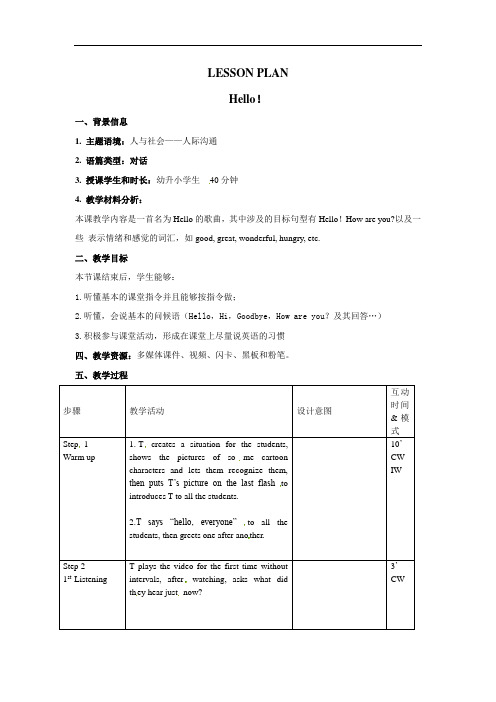
LESSON PLANHello!一、背景信息1. 主题语境:人与社会——人际沟通2. 语篇类型:对话3. 授课学生和时长:幼升小学生40分钟4. 教学材料分析:本课教学内容是一首名为Hello的歌曲,其中涉及的目标句型有Hello!How are you?以及一些表示情绪和感觉的词汇,如good, great, wonderful, hungry, etc.二、教学目标本节课结束后,学生能够:1.听懂基本的课堂指令并且能够按指令做;2.听懂,会说基本的问候语(Hello,Hi,Goodbye,How are you?及其回答…)3.积极参与课堂活动,形成在课堂上尽量说英语的习惯四、教学资源:多媒体课件、视频、闪卡、黑板和粉笔。
五、教学过程步骤教学活动设计意图互动时间&模式Step 1 Warm up 1.T creates a situation for the students,shows the pictures of so me cartooncharacters and lets them recognize them,then puts T’s picture on the last flash tointroduces T to all the students.2.T says “hello, everyone” to all thestudents, then greets one after ano ther.10’CWIWStep 21st Listening T plays the video for the first time withoutintervals, after watching, asks what didth ey hear just now?3’CWStep 32nd Listening T plays the video for the 2nd time, whenthere is target language, stops for remindingthem and repeating.9’CWStep 5 Acting T plays the video for the 3rd time, then askssome students to act out.10’IW&CWStep 6 Summary Review what we have learned today andp lay goodbye song.8’CW备注:Ss: Students T: Teacher IW: Individual work GW: Group work CW: Class work 六、教学反思(课后立即补上)。
Lesson planning
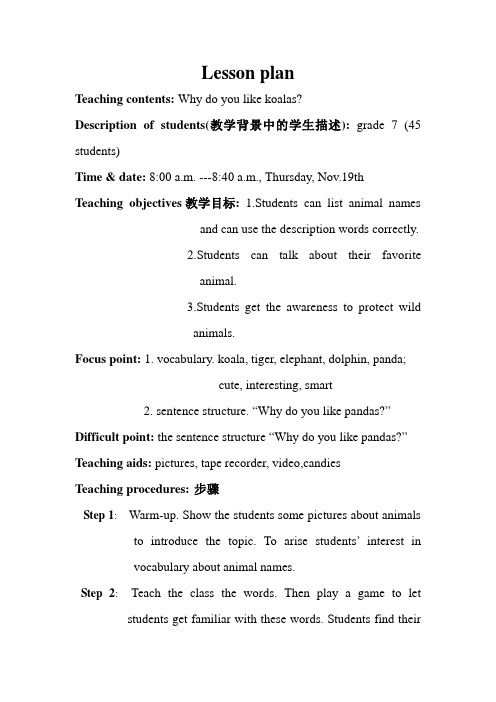
Lesson planTeaching contents: Why do you like koalas?Description of students(教学背景中的学生描述): grade 7 (45 students)Time & date: 8:00 a.m. ---8:40 a.m.,Thursday, Nov.19th Teaching objectives教学目标:1.Students can list animal namesand can use the description words correctly.2.Students can talk about their favoriteanimal.3.Students get the awareness to protect wildanimals.Focus point: 1. vocabulary. koala, tiger, elephant, dolphin, panda;cute, interesting, smart2. sentence structure. “Why do you like pandas?”Difficult point: the sentence structure “Why do you like pandas?”Teaching aids: pictures, tape recorder, video,candiesTeaching procedures:步骤Step 1: Warm-up. Show the students some pictures about animals to introduce the topic. To arise students’interest invocabulary about animal names.Step 2: Teach the class the words. Then play a game to let students get familiar with these words. Students find theirpartner,one imitate a kind of animal,and another guesswhich animal is. The pair who guess most is the winner.Students participated can get candes.Step 3:Listen and read. Listen to the tape and complete the conversation. Teacher explain the sentence structure, thenstudents read after the tape.Step 4: Interview. Students walk around the classroom to interview their classmate their favorite animal and ask why, then give areport. Teacher can correct their mistakes they made duringthe presentation. Let student practise the main sentencestructure and the adjective word.Step 5:Watch a video of 可可西里, call the student on protecting the wild animalsStep 6: Sum up and assign homework.surfing on the internet to find more words about animals;remember the words learned today.After class reflection:2006级8班程小芳。
LessonPlan教案(一般过去时动词过去式)Lily
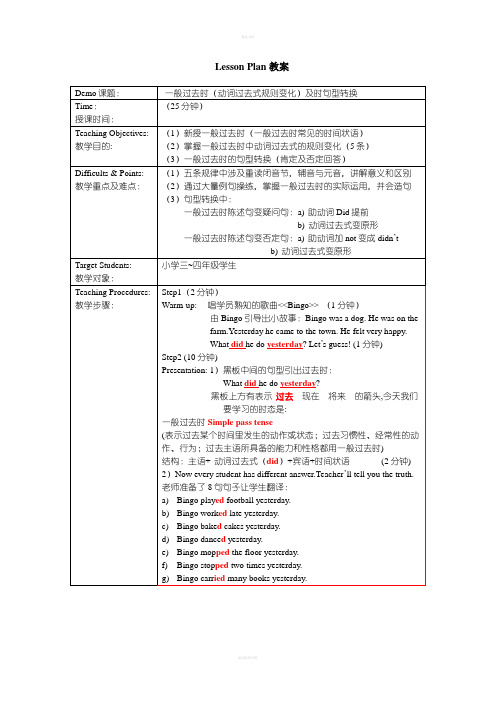
Lesson Plan教案Step1(2分钟)Warm-up: 唱学员熟知的歌曲<<Bingo>> (1分钟)由Bingo引导出小故事:Bingo was a dog. He was on thefarm.Yesterday he came to the town. He felt very happy.What did he do yesterday? Let’s guess! (1分钟)Step2 (10分钟)Presentation: 1)黑板中间的句型引出过去时:What did he do yesterday?黑板上方有表示过去现在将来的箭头,今天我们要学习的时态是:一般过去时Simple pass tense(表示过去某个时间里发生的动作或状态;过去习惯性、经常性的动作、行为;过去主语所具备的能力和性格都用一般过去时)结构:主语+ 动词过去式(did)+宾语+时间状语(2分钟) 2)Now every student has different answer.Teacher’ll tell you the truth. 老师准备了8句句子让学生翻译:a)Bingo play ed football yesterday.b)Bingo work ed late yesterday.c)Bingo bake d cakes yesterday.d)Bingo dance d yesterday.e)Bingo mop ped the floor yesterday.f)Bingo stop ped two times yesterday.g)Bingo carr ied many books yesterday.. . .。
lesson,plan,模板

竭诚为您提供优质文档/双击可除lesson,plan,模板篇一:lessonplan模板lessonplanunit2lesson1aperfectday(示例)本课是第xx单元第xx课。
本单元围绕xxx话题。
本课计划按两次课完成:第一次课关于warmingupandreadingcomprehension;第二次课xxxxx。
......(示例)period1:warmingupandreadingcomprehension(示例)(90min)objectives1.knowledgeobjectives:1)masterthenewwordsandexpressions2)tousetimelinkers,especiallyadverbsandconjunctions2.abilityobjectives:1)learnaboutthegeneralideaofthetextthroughfastreadi ng2)findoutthedetailedorspecificinformationthroughint ensivereading3)practicestudents’abilitytousethestrategyofpredicationandreference3.emotionobjectives:1)tolearntheheroicspiritofyangliwei2)togetandarrangetheinformationaboutspaceship3)todescribetheprocessoftheflightandthefeelingsofya ngbythewordsandexpressionslearnedinthislesson(此部分可根据实际情况删减)contents1.words:astronaut,flight,launch,rocket,atmosphere,helicopte r,parachute,gravity,manndspaceship,separate…from,becauseof,letout,millionsof......2.expressions:separatefrom与……分离,becauseof因为,由于,liftoff起飞,升空,发射......3.sentences:1)thespaceship,calledshenzhouⅤ,wascarryingchina’sfirstastronaut,yangliwei.2)whenthespaceshipwasdoingitsseventhcircle,yangliwe ishowedtheflagsofchinaandtheunitednations,expressin gthewishesofthechinesepeopletoexploreandusespacepea cefully.municativetasks:questionscanbebasedondetailsin thetext.whydopeoplethinkyangliweiisaherowhatcanwelearnfromyangliwei ……keypointsanddifficulties1.findoutthemainideaanddetailedinformationthroughex tensiveandintensivereading.2.todescribetheprocessoftheflightbythewordsandexpressionslearnedinthislesson.teachingapproachestask-basedteaching,scanning,intensivereading,rolepl ay,pair-worksdebutlaunch.长征七号运载火箭20xx年6月25日晚在海南文昌发射场首飞成功。
Lesson plan 详细版

Lesson planUnit 5 Traveling AbroadPeriod 1 Warming-up and readingTime: 45 minutesThe number of students: 50The grade of students: grade two in high school1.The analysis of teaching materials:This unit forms a part of high school English teaching material, Student’s Book 7. This unit can be divided into three parts: warming-up, reading, listening about language. Its main topic is traveling abroad and it contains two reading materials, studying in foreign country and traveling in foreign country. Today,we will learn the first part, studying in a foreign country. In this unit, it tells students what problems they will meet in foreign countries and how to deal with these problems. Also, it introduces the benefits and difficulties of studying abroad through the story of Xie lei.2.The analysis of students:As high school students, they have learned English for several years and they have a basic command of English. Students will be interested with a certain topic easily, such as traveling, sports healthy life and so on, which adapts to their physical and psychological characteristics. Additionally, students are weak in English speaking, so in my class, I will design some questions and activities for them to practice their pronunciation.3.Teaching aims:Knowledge aim:a)Students will learn about Xie L ei’s school life in London.b)Students will learn new words and phrases including lecture,academic, comfort, requirement, acknowledge, preparation, contradict, occupy, recommend, substitute.Ability aim:a)Students will be able to use the new words about traveling abroadto describe the life in foreign countries.b)Students will be able to think of their own way to deal with thepossible problems of living abroad.c)Students will be able to know how to read the news report and getthe main idea by finding the key information about what, when, why, where and who.Emotion aim:a)Students will be more interested in traveling or studying abroad.b)Students can overcome the difficulties in study and life afterreading Xie Lei’s story.Learning strategy aim:a)Students will learn about the characteristics of the news reportand get the main idea by finding the main words, who, when, where, why, what.Culture aim:a)Students will gain more knowledge about the lifestyle and theweather feature in London.2.Key point:a)Learning the new words and phrases about traveling abroad and knowtheir meanings, such as requirement, acknowledge, preparation, fit in.b)Learning about the benefits and difficulties of studying abroad.3.Difficult point:a)Grasping the ability to skim and scan the text and the ability tosummarize the main idea of each paragraph. It requires students to summarize the main idea according to find the key information about what, when, why, who, where.b)Learning the basic structure of emphatic sentence and how to useit. It requires students to be able to use it in the composition.4.Teaching aids:Power Point, a blackboard, some chalk, a tape recorder5.Teaching methods:Task-based language teaching6.Teaching procedure:Step1 Lead-in (4 minutes)At first,the teacher will ask students a question, if you have a chance to go abroad in the world, which country would you like to go? Why? Fifteen seconds later, the teacher will choose two students to tell their answers. After hearing these answers, the teacher will show some beautiful pictures of different countries to attract students’ attention, such as Statue of Liberty, Sydney Opera House, Eiffel Tower and so on(5 slides)and next the teacher will ask students whether they want to go abroad to have afurther study or not.Step2 pre -reading(6minutes)Nowadays, more and more students wants to go abroad to have a further study. What are the advantages and disadvantages of studying abroad? Then the teacher will ask students to discuss in the four-people group.Suggested answers:T:”You are going to read a newspaper article about a Chinese student who goes to study in England. What do you think she willfind differences from studying at a Chinese school/university?”Step3 listening and fast reading (5minutes)1. Listen to the tape and find the answers to the following questions.1)Who is the main character?2)Will she overcome difficulties at last? Who helps her?3)What is Xie Lei in England for? How long has she beenin England?2. True or False.a.When Xie Lei went to New York, she felt very excited and relaxed.b.Xie Lei came to the university to complete a sciencequalification.c.Xie Lei lives in the student accommodation.d.Xie Lei found the preparation course was very easy tolearn at first.e.Xie Lei’s tutor helped her a lot in her study.Step4 detailed reading (12minutes)1.Summarize the main idea of the passage (the teacher will give students three minutes to skim the whole text and summarize the main idea)Suggested answer:The text mainly tells us a Chinese student named Xie Lei is studying at an English university, which introduces us her study life there and how she solved the difficulties she faced.2. Put the events into order_3__The difficulties Xie Lei met while living in London;_7__The newspaper will follow Xie Lei’s progress in later editions._2__The general introduction to Xie Lei and her study;_1__The advantages that Xie Lei gained while living with a host family._6__Xie Lei is now getting along well and is living an act ive life._4__ Xie Lei, a Chinese girl, is studying in a foreign c ountry--London._5__Xie Lei is getting used to the Western University’s way of learning.3.Answer questions( The teacher will invite four volunteers to answer the four questions)1)Why is she doing a preparation course first?2)What are some of difficulties she faced when she firstcame to England?3)Why does Xie Lei have such a decision that she would like to board with a host family while studying in Engla nd?4)How does Xie Lei try to get used to the new sociallife in England?Step5new words(8minutes)Firstly, the teacher will ask students to find out the new words in the first two paragraphs when they are reading it. Next, the teacher will check the new words that students find in the two paragraphs. Then the teacher will explain its meaning in the text and he will also expand its relevant phrases.For example:Step6 text analysis (9minutes)The teacher will write the example of emphatic sentence in the blackboard and tell students what an emphatic sentence is and then the teacher will ask students to make other sentences according to the sentence in the blackboard. Next, students will finish four single-choice questions about this grammar point in the PowerPoint. (强调句详情在幻灯片上可见)课文原句:It’s not just study that’s difficult.It is/ was + 被强调部分(通常是主语、宾语或状语)+ that/ who(当强调主语且主语指人)+ 其他部分。
- 1、下载文档前请自行甄别文档内容的完整性,平台不提供额外的编辑、内容补充、找答案等附加服务。
- 2、"仅部分预览"的文档,不可在线预览部分如存在完整性等问题,可反馈申请退款(可完整预览的文档不适用该条件!)。
- 3、如文档侵犯您的权益,请联系客服反馈,我们会尽快为您处理(人工客服工作时间:9:00-18:30)。
Lesson planUnit 5 Traveling AbroadPeriod 1 Warming-up and readingTime: 45 minutesThe number of students: 50The grade of students: grade two in high school1.The analysis of teaching materials:This unit forms a part of high school English teaching material, Student’s Book 7. This unit can be divided into three parts: warming-up, reading, listening about language. Its main topic is traveling abroad and it contains two reading materials, studying in foreign country and traveling in foreign country. Today,we will learn the first part, studying in a foreign country. In this unit, it tells students what problems they will meet in foreign countries and how to deal with these problems. Also, it introduces the benefits and difficulties of studying abroad through the story of Xie lei.2.The analysis of students:As high school students, they have learned English for several years and they have a basic command of English. Students will be interested with a certain topic easily, such as traveling, sports healthy life and so on, which adapts to their physical and psychological characteristics. Additionally, students are weak in English speaking, so in my class, Iwill design some questions and activities for them to practice their pronunciation.3.Teaching aims:Knowledge aim:a)Students will learn about Xie L ei’s school life in London.b)Students will learn new words and phrases including lecture,academic, comfort, requirement, acknowledge, preparation, contradict, occupy, recommend, substitute.Ability aim:a)Students will be able to use the new words about traveling abroadto describe the life in foreign countries.b)Students will be able to think of their own way to deal with thepossible problems of living abroad.c)Students will be able to know how to read the news report and getthe main idea by finding the key information about what, when, why, where and who.Emotion aim:a)Students will be more interested in traveling or studying abroad.b)Students can overcome the difficulties in study and life afterreading Xie Lei’s story.Learning strategy aim:a)Students will learn about the characteristics of the news reportand get the main idea by finding the main words, who, when, where, why, what.Culture aim:a)Students will gain more knowledge about the lifestyle and theweather feature in London.2.Key point:a)Learning the new words and phrases about traveling abroad and knowtheir meanings, such as requirement, acknowledge, preparation, fit in.b)Learning about the benefits and difficulties of studying abroad.3.Difficult point:a)Grasping the ability to skim and scan the text and the ability tosummarize the main idea of each paragraph. It requires students to summarize the main idea according to find the key information about what, when, why, who, where.b)Learning the basic structure of emphatic sentence and how to useit. It requires students to be able to use it in the composition.4.Teaching aids:Power Point, a blackboard, some chalk, a tape recorder5.Teaching methods:Task-based language teaching6.Teaching procedure:Step1 Lead-in (4 minutes)At first,the teacher will ask students a question, if you have a chance to go abroad in the world, which country would you like to go Why Fifteen seconds later, the teacher will choose two students to tell their answers. After hearing these answers, the teacher will show some beautiful pictures of different countries to attract students’ attention, such as Statue of Liberty, Sydney Opera House, Eiffel Tower and so on(5 slides)and next the teacher will ask students whether they want to go abroad to have a further study or not.Step2 pre -reading(6minutes)Nowadays, more and more students wants to go abroad to have a further study. What are the advantages and disadvantages of studying abroad Then the teacher will ask students to discuss in the four-people group. Suggested answers:T:”You are going to read a newspaper article about a Chinese student who goes to study in England. What do you think she willfind differences from studying at a Chinese school/university”Step3 listening and fast reading (5minutes)1. Listen to the tape and find the answers to the following questions.1)Who is the main character2)Will she overcome difficulties at last Who helps her3)What is Xie Lei in England for How long has she beenin England2. True or False.a.When Xie Lei went to New York, she felt very excited and relaxed.b.Xie Lei came to the university to complete a sciencequalification.c.Xie Lei lives in the student accommodation.d.Xie Lei found the preparation course was very easy tolearn at first.e.Xie Lei’s tutor helped her a lot in her study.Step4 detailed reading (12minutes)1.Summarize the main idea of the passage (the teacher will give students three minutes to skim the whole text and summarize the main idea) Suggested answer:The text mainly tells us a Chinese student named Xie Lei is studying at an English university, which introduces us her study life there and how she solved the difficulties she faced.2. Put the events into order_3__The difficulties Xie Lei met while living in London;_7__The newspaper will follow Xie Lei’s progress in later editions._2__The general introduction to Xie Lei and her study;_1__The advantages that Xie Lei gained while living with a host family._6__Xie Lei is now getting along well and is living an act ive life._4__ Xie Lei, a Chinese girl, is studying in a foreign c ountry--London._5__Xie Lei is getting used to the Western University’s way of learning.3.Answer questions( The teacher will invite four volunteers to answer the four questions)1)Why is she doing a preparation course first2)What are some of difficulties she faced when she firstcame to England3)Why does Xie Lei have such a decision that she would like to board with a host family while studying in Engla nd4)How does Xie Lei try to get used to the new sociallife in EnglandStep5new words(8minutes)Firstly, the teacher will ask students to find out the new words in the first two paragraphs when they are reading it. Next, the teacher will check the new words that students find in the two paragraphs. Then the teacher will explain its meaning in the text and he will also expand its relevant phrases.For example:boardn.&vt. 上(船,车,飞机等);付费;木板;布告牌above board 光明正大地across the board 全面的;全盘的sweep the board 全胜,大获全胜boarding card 登船证/登机证boarding house 旅馆;寄宿房屋recommendvt. 推荐,介绍;劝告,建议recommend sb.= recommend ...to sb. 向某人推荐,介绍recommend sb. for 推荐某人做……recommend sb. as 推荐某人为……recommend sb. to do sth. 建议某人做某事Step6 text analysis (9minutes)The teacher will write the example of emphatic sentence in the blackboard and tell students what an emphatic sentence is and then the teacher will ask students to make other sentences according to the sentence in the blackboard. Next, students will finish four single-choice questions about this grammar point in the PowerPoint. (强调句详情在幻灯片上可见)课文原句:It’s not just study that’s difficult.It is/ was + 被强调部分(通常是主语、宾语或状语)+ that/ who(当强调主语且主语指人)+ 其他部分。
